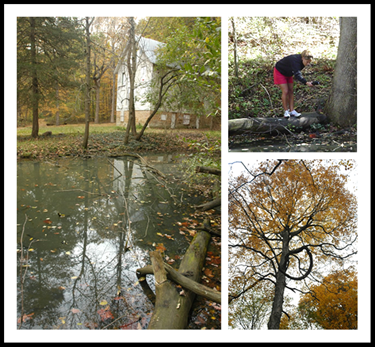The Ira & Reatha T. Post Wildlife Sanctuary
A Brief History
The town of Vishnu Springs, located west of Tennessee, IL, was founded ca. 1880 as a health retreat/spa. The town reportedly hosted as many as 3,000 visitors, annually, and contained a hotel, restaurant, blacksmith shop, fishing pond, race track, and a school. By the 1920s, the town was defunct and remained so despite intermittent efforts at revival. Part of the town was used as a commune through the 1970s and has been uninhabited since it was abandoned in 1980. The only remaining structure is the Capitol Hotel. The property is currently owned by Western Illinois University Foundation and is known as the Ira & Reatha T. Post Wildlife Sanctuary.

Capital Hotel ca. 1884.(LEFT) Capitol Hotel ca. 1890 (courtesy of the WIU Archives). (RIGHT) Capitol Hotel, October, 2007 (photo by L. Dean).
Opportunities
Since the site was occupied only sparingly since the 1920s, there are significant opportunities to study processes relevant to the recovery of disturbed natural systems in western Illinois and beyond. Likewise, the collection and preservation of cultural and historical remnants from the unique communities that occupied the site can enhance our understanding of western Illinois’ rural heritage.
To develop these opportunities, a multidisciplinary inventory of assets at the Post Wildlife Sanctuary is being conducted; representative examples of this work include: groundwater monitoring, assessment and characterization of biological communities, and mapping of natural and historic resources. Collaborators on this multidisciplinary project include the Departments of Biological Sciences, Geology, & Geography; the WIU GIS Center, and the Institute for Environmental Studies.
This work engages students and faculty in meaningful applied research, provides an informed basis on which future site management decisions can be based, supports environmental stewardship, and reinforces the need for, and value of, multidisciplinary scholarship.

Autumn colors. (LEFT) Spring-fed pond with the Capitol Hotel in the background. (Photo by L. Dean). (RIGHT TOP) WIU Biological Sciences graduate student, S. Goddard (MS 2010), collecting water quality samples (photo by R. Viadero). (RIGHT BOTTOM) Autumn colors (Photo by L. Dean). All photos taken October 2007.
Inventory of Natural and Historic Resources at the Ira & Reatha T. Post Wildlife Sanctuary
An Outline of Our Work
Installation of Groundwater Monitoring Wells — Department of Geology
Based on preliminary findings, the Spring appears to be fed by a bedrock aquifer with a large recharge area. Three shallow groundwater monitoring wells are being installed to determine the orientation of the water table surface and determine the direction of groundwater flow. Comparisons are also being made between the water chemistry of the local groundwater flow system with the larger flow system that feeds the Spring. This is the first step toward developing a more extensive groundwater monitoring program.
Assessment & Characterization of Biological Productivity & Water Quality — Department of Biological Sciences and the Institute for Environmental Studies
The spring and pond located near the old Capitol Hotel are potential sources of biological productivity. Consequently, seasonal sampling will be conducted to determine the presence and abundance of aquatic organisms and assess their relevance in terms of environmental quality. To compliment the work of others, a comprehensive water quality study will be conducted to characterize the spring, pond, and ground waters. This work will also allow the group to build on rare historic water quality data from 1889, obtained from the archives of the WIU Library. The outcomes of this work will provide a scientific basis on which future management decisions related to the spring, pond, and adjacent water bodies can be made.
![]() Click the icon to open a presentation on groundwater wells and water chemistry presented by Mr. Jonathan Love, an undergraduate student in the Department of Geology (2008).
Click the icon to open a presentation on groundwater wells and water chemistry presented by Mr. Jonathan Love, an undergraduate student in the Department of Geology (2008).
Mapping of Natural & Historic Resources — Department of Geography and the WIU GIS Center
Undergraduate and graduate students are mapping existing and historic infrastructure at the site , as an initial effort to develop a comprehensive basemap. This initial step provides the basis for the future development of three dimensional reconstructions of historic resources, including the pump house, residences, etc. The basemap will serve as the centerpiece for depicting, tracking, and integrating the wide variety of investigations conducted at the site and will be a key tool for communicating the scope and importance of the Team’s work.
Click here to see a 3-D rendering of the historic town of Vishnu Springs created by Prof. Chris Sutton and his students. (Scroll down to see the 3D Map of Vishnu Springs.)

Connect with WIU: